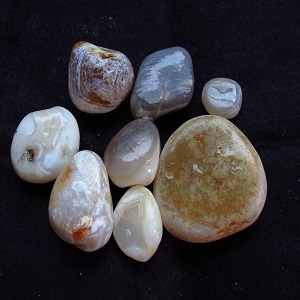A history of ammolite stone
Ammolite is a fossilized ammonite. In fact, it is the ring shell of today’s squid that lived about 65 to 410 years ago. The origin of the name of ammolite is derived from Ammon, the ancient Egyptian god in the shape of a ram’s head with twisted horns. This stone has a design like a rainbow
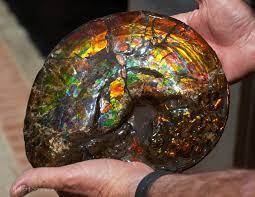
Ammonite is found all over the world, but Canadian ammonites from Alberta have an incredibly clear and shiny color. Canadian ammonites can be seen in sizes as large as 90 cm in diameter and with a rainbow of green and red colors. Requests for any Canadian amulets, whether scientific or demonstrative, must be made with the consent of the King of Canada
Ammolite is also known as ammonite, which is considered one of the rarest gemstones on the planet. Ammolite belongs to a small group of organic gemstones that also includes amber, coral, black amber and pearl
The most famous varieties and similar brand names
Labradorite, precious opal, black opal, fire opal, chocolate opal, mother of pearl, mother of pearl, coral, fossil coral, amber and black amber are some of the most famous types of gemstones and associated trade names
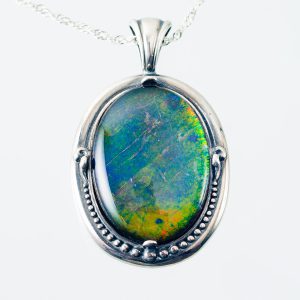
Ammolite color
Very attractive, opal-like, iridescent colors are usually green and red, but spectral colors are also found. High-grade emmolite should not show a visible matrix
It is expected that the resources and reserves of ammolite will be depleted during the next twenty years. Ammolite often has a scaly or “dragon skin” surface. If this feature is higher than the specified limit, it will reduce the value of the ammolite stone
Ammolite is also known as “aapoak” from an Indian word meaning “small and crawling stone”
Other trade names include gem-ammonite, korite and calcentine. Korite is an international mining company and the world’s leading supplier of gem-quality ammolite
The term “ammonite” was originally used to describe spiral-shaped fossilized shells that resembled ram’s horns. Ammolite is made up of the remains of fossilized ammonite shells, mostly aragonite, and this is the same material that makes up pearlescent pearls
Variety of Ren Ammolite
Ammolite can be found in a rainbow of colors, but the most precious and rare colors are red, gold, green, blue and purple. Ammolites must have at least two colors
A rainbow produces a set of light similar to agate in an ammolite. Rangamolite depends on the light angle and viewing angle. The rainbow varies from subtle to extreme changes
Ammolite has a chromatic color change such as red to green or green to blue (two colors). Some color variations of ammolite are limited to one primary color group (monochrome). The most valuable ammolite changes the entire color spectrum (color spectrum)
The rotational spectrum, in addition to the color movement, affects the value of the ammolite. The best emmolite displays vivid colors from a full 360-degree rotating spectrum. Others use only a limited rotation range
Species with a color range of 241-360 and 180-240 degrees are more desirable. Varieties with color grade limits of 90 to 179 are not as valuable, but since all ammolites are rare, gem-quality varieties are highly sought after
Garlic red, purple and golden ammolite are among the rarest color combinations
Amolite quality
Polish, grade and color of ammolite are three important determining factors in checking the quality of this stone. The more colorful and shiny the stones are, the better they are. Ammolites are considered to be of high quality if they have 3 or more colors and the space between the colors, the dark separators, is considered as a special pattern. Stones that have special patterns, such as ribbon patterns, stained or patterned glass, are considered to be of high quality
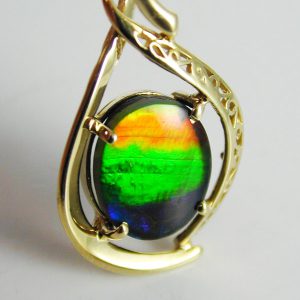
The brilliance of ammolite
Ammolite is naturally opaque. Almost all oommolite species contain part of the host matrix (usually clay, limestone or clay)
Mullite has an almost vitreous luster and when fixed with epoxy, polymer or resin, it takes on a somewhat resinous appearance
Diagnosis of emollitis
Stones such as labradorite, spectrolite and agate, all of which have a similar appearance to ammolite, are examples of this stone. However, ammonite is usually easily distinguished through careful testing. Ammolite’s brilliance is the result of aragonite’s unique microstructure, which sets it apart from many other iridescent gemstones
Usually this rainbow is caused by the absorption of light, but the color of ammonite is caused by the interference of light and returning to the thin plate, which is part of the organic structure of aragonite. Labradorite is often found in blue and purple colors, while ammolite is commonly found in red and green colors. Labradorite and colored opal rotate within the stone, and this is the opposite for ammolite
The visible structure of ammolite is also very unique, which will differentiate them. According to the viewing angle, similar samples are usually transparent to translucent, but natural ammolite is opaque
Amolite price
Due to the variety of characteristics of each stone, it seems difficult to calculate a certain price for it. The price of ammolite is calculated based on its characteristics per square millimeter. Triplets are priced from $100 to $1,000 and natural stones from $250 to $2,500
How to maintain ammolite
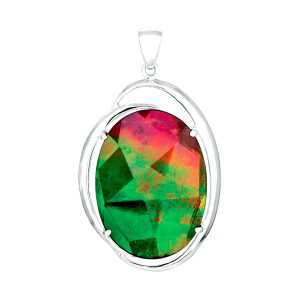
Ammolite with a hardness of 4.5 needs special care. When hanging jewelry decorated with ammolite, its contact with any acidic substances, ammonia, hair sprays and perfumes should be prevented
To clean it, you should use a soft brush and dilute soap and water solution or special pearl cleaner
With ammolite jewelry in different shapes, you will find that by using ammolite, you are able to present a variety of exquisite and beautiful works. The fossils of this stone in the rainbow, red, green patterns of creatures and sometimes the layers of colors are so thin and delicate that they cannot be separated from natural stone
Ammolite-like stones
similar to emmolite can be produced with difficulty. However, there are also gemstones with many similarities, such as labradorite, spectrolite, and opal. Although ammolite is rarer than agate, black agate is more valuable, and in this case it is sometimes used as black agate
Since ammolite belongs to the organic group of gemstones, some types of organic stones as well as some types of marble have many similarities with ammolite
Ammolite is mainly composed of the remains of fossilized shells of ammolites, which also form the composition of shiny pearls, pearls and mother of pearl are very closely related to the fossils of ammolite
As a fossil gemstone, its formation process is similar to fossil coral, amber, hardened wood, and black amber. The iridescent colors and visual phenomena of ammolite are very unique, but it is not the only gem with stunning color effects
Other gemstones that exhibit beautiful and rare colorful works are sodalite, rainbow pyrite, fire agate, various agates, and moonstone
Ammolite stone sources
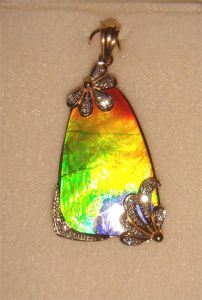
Sources of ammolite occur in various parts of the world, but are primarily (over 90%) found in an area along the eastern slopes of the Canadian Rockies in Alberta. In 1981, ammolite mining was promoted to commercial level, and during this time, the Confederation of International Gemstones (CIBJO) recognized ammolite as an official variety of colored gemstones
In 2004, Alberta declared ammolite as its regional stone, and in 2007, the city of Lethbridge named ammolite as its official gemstone. The best deposits are located along a river in the eastern foothills of the Canadian Rockies. Most of the commercial mines are located along the St. Mary’s River, and approximately 50% of all ammolite is mined from the Kainah deposits of India
Since 2003, the eco-friendly mining company, Korite International, has been the world’s leading supplier of gem-quality ammolite. Seafire Gems in Utah also produces examples of the finest gem-quality ammolite. If the current rate of ammolite extraction continues, it is expected that the ammolite mines will be depleted within 20 years

